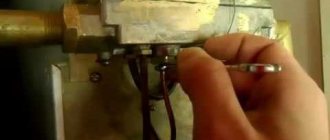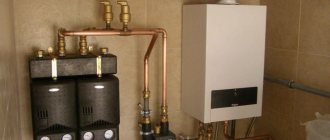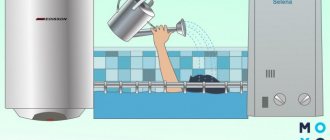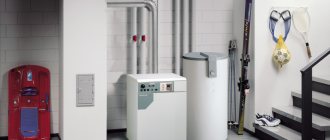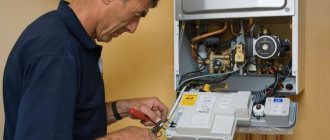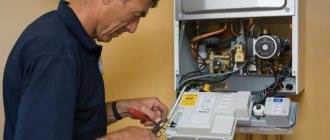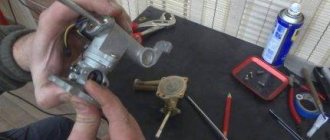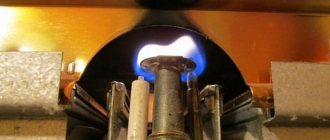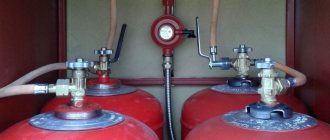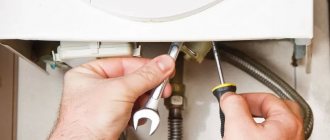Among the huge variety of water heating equipment, it can be quite difficult for the average consumer to choose the right model for their home. Knowledge of the basic principle of operation of devices, technical characteristics and design features will help to deal with this difficult issue. Together with experts from the online magazine Seti.guru, we’ll look at what a Neva gas water heater is, the criteria for choosing water heating devices, and a detailed overview of the model range.
Gas water heater Neva 4511
About company
The history of the Gazapparat enterprise began in 1945, when gas deposits were discovered near Saratov. This was the impetus for the construction of a plant for the production of gas equipment. At first, gas stoves and stove burners were made here. Later they began to produce water heaters, which were constantly improved and modernized.
The speakers are a worthy competitor to imported analogues. The equipment of the Russian plant can operate in a wide variety of climatic conditions. The company's products are imported to the countries of Europe, Africa, and Asia.
When a Neva gas water heater is used, its purpose
Despite the fact that many modern houses have a centralized supply of hot water, domestic gas water heaters have not lost their relevance. Such equipment provides comfortable living conditions for many ordinary people. Instantaneous heaters allow you to use hot water for domestic needs at any time convenient for consumers and do not depend on the work of municipal utilities.
Among the huge number of imported and domestic geysers on the market, it is worth highlighting Neva brand devices. The products are manufactured at the Russian enterprise Gazapparat, are equipped with modern automation and have high build quality. All models are designed taking into account the operating characteristics of domestic gas and water mains, which ensures uninterrupted operation of the equipment.
Design
Structurally, the Neva columns are:
Flow-through. They are compact - small dimensions are achieved due to the absence of a storage tank. Such devices are suitable for small, well-ventilated rooms. The productivity of flow devices is low. If a flow column is purchased to serve several water intake points, you will have to choose a version with high power.
Flow-type devices are often chosen by apartment owners.
Cumulative. They have impressive dimensions. Tank capacity - 50–500 l. It contains a supply of heated water. Effective thermal insulation prevents it from cooling down. To use hot water, you do not need to start the device every time. Storage columns are equipped with efficient heat exchangers.
The disadvantage of such water heaters is their size - due to their large dimensions, they have to be installed in special rooms, in basements or attics. Such devices are usually purchased for private homes. If the consumer chooses the Neva 4511 storage type version, the weight of the water tank should be taken into account - a concrete base will have to be prepared.
Main problems and repairs of the Neva gas water heater
Neva column does not light up
If the Neva gas water heater does not ignite, first of all you should check the electronic unit that generates the spark. As a rule, the problem is solved by replacing it. This is quite simple to do, for which you need to remove the front screen, then unscrew the fastening bolts and remove the power wires (the new unit is installed in the reverse order).
Water unit of the Neva column
Why does the Neva gas water heater not turn on?
Let's look at the main causes of malfunctions of Neva brand water dispensers, due to which the equipment will not turn on and heat the water. They are typical for the entire model range. One of them is the lack of draft in the ventilation ducts. The problem is solved by cleaning the chimney shaft, for which you should use a brush with steel bristles.
Construction of a water-gas unit for Neva 4510, 4511, 4513 series dispensers
If the column has an automatic ignition system, you should check the operation of the generator, batteries, and the power button. Most often, the unit does not turn on because the batteries are dead. It is enough to replace them with new ones and clean the contacts.
Replacing batteries in the electric ignition system
Weak pressure in the water and gas supply (there is a spark, the column does not work) will also prevent the device from turning on. The solution to this problem is to call specialists from the relevant services to clean the lines.
Where to find spare parts for the Neva gas water heater
Spare parts can be easily purchased from official dealers specializing in the sale of gas and water heating equipment. In most Russian cities there are representative offices of various manufacturing companies where you can purchase certified products, which guarantees long-term operation of the devices. The same can be done in online stores (request quality certificates for the spare parts offered).
Repair kit for geysers Neva
What should the water pressure be?
Normal operation of water heaters requires a certain pressure in the water pipes:
- minimum - if it is below the set value, the launch will not occur;
- the maximum is what the heat exchanger can withstand.
The first parameter is especially important for flow-through versions: they will not turn on if the pressure is insufficient and there will be no hot water. This characteristic is especially important for residents of older houses with worn-out systems, where the pressure is often low. Such buyers need to choose options with a minimum threshold of no more than 0.15 bar.
No less important is the maximum value that the device can withstand. In the water supply system there are water hammers, leading to short-term increases in pressure. Such situations can lead to rupture of the coolant. Experts recommend buying devices that can withstand 11–12 bar.
Ignition type
Neva water heaters have the following ignition type:
- Manual. To turn on the column, the user has to press the ignition button and bring the fire to the igniter. Old models made in the last century are equipped with this ignition method. This is an inconvenient, and most importantly, unsafe way to launch. In addition, this is an uneconomical option: the wick burns constantly, wasting gas.
- Piezo ignition. This method of ignition, for example, is in modification 3208. The fire is activated by pressing a button. The first ignition of the wick is done manually - to do this, press two buttons at once: gas and piezo ignition. In the future, to start the device, you only need to open the tap - the igniter will ignite the main burner and a hot stream will appear at the outlet. The disadvantage of this type of ignition is the constant burning of the igniter.
- Electric ignition. Instead of a wick, a source of electricity is used, which is powered by batteries. This method allows you to save gas. This type of ignition is available for models 4511, 5011 and 5014.
Electric ignition is the most modern and convenient way to start. Automatic ignition can be volatile or non-volatile. The first option is bad because if there is a power outage, the device will not be able to start - the user, along with the power outage, will also lose hot water. The most reliable and convenient way is to power it from batteries; the main thing is to have spare ones on hand.
The general principle of operation of Neva geysers and their types
Let's consider the operating principle of Neva household water heating gas equipment and its varieties. The dispensers differ in the type of ignition of the incoming fuel, design features of the chimney, power, weight and size indicators, level of safety and the presence of additional functions.
Diagram of the Neva gas water heater
Related article:
Repair of geysers at home. In this publication we will look at the design and operating principle of geysers, the main types of malfunctions and how to eliminate them.
The operating principle of Neva brand dispensers is as follows: after opening the valve, water flows under pressure into the cavity of the water-gas unit (12). It has a membrane that acts through the stem on the valve. After it opens, the gas enters the main burner (10).
Thanks to the electrode, the gas is ignited using a pilot burner (3). In turn, the water flows into the heat exchanger pipeline (2), where it is heated to a certain temperature and supplied to all intake points in the home. The principle of construction of Neva geysers is almost the same. All models have a long warranty period (for example, for the Neva 4511 brand it is 12 years).
How to choose power
The capabilities of the water heater depend on the power - the more powerful it is, the better it heats the water. If the power is low, the device will not be able to provide hot water to several points.
Columns are usually divided into:
- low-power - 17–20 kW;
- medium - 20–26 kW;
- powerful - 26–28 kW.
Low-power versions are taken for one water intake point. If hot water is required in the kitchen and bathroom, medium power is needed. So, for 2-3 points, Neva Lux 5011 or 5014 is suitable. To provide 3-4 points, you will need a powerful version. The more powerful the modification, the higher its cost.
The combustion chamber
produces water heaters with both types of fireboxes - closed and open. In the first case, forced draft is used, in the second - natural.
A coaxial chimney is connected to models with a closed chamber. Its design allows for the simultaneous removal of gases and the supply of combustion air. Open chambers involve the absorption of air from the room. Such modifications require a traditional chimney.
Versions with open fireboxes are installed in rooms that meet safety requirements:
- area from 8 m²;
- effective ventilation system made of heat-resistant material.
Safety system
The basis for the safety of gas equipment is a well-thought-out emergency protection system. The manufacturer has equipped all modifications of Neva gas water heaters with sensors that monitor the operation of the device and ensure its safe operation. Protection is provided by the following elements:
- Sensors: flame; water pressure; temperature control.
- Safety valve.
- Thermal relay.
Sensors that monitor temperature changes are installed on improved versions of the Neva Lux boilers 4513 and 4514. These elements allow you to change the water temperature if water intake points are connected or disconnected.
Specifications
Gas water heaters are produced in 3 types of power - low, medium, maximum. Water heaters have high efficiency and are able to maintain the temperature of the water.
Gas heaters are equipped with safety sensors, they minimize the possibility of fire. When the burner goes out or the liquid supply stops, the column turns off. Built-in sensors for controlling draft, flame, and temperature ensure simple and safe use of the device. Hanging models are small in size.
Model overview
Let's look at the best models.
Neva 4511
Atmospheric type water heater. Power - 21 kW. Suitable for 2 water intake points, no more. This is the most compact version in the entire series, and it is the one that is most suitable for tight spaces. Approximate price - 9,000 rubles. Control is mechanical. Ignition is from batteries.
Specifications:
| Capacity, l/min | 11 |
| Nominal thermal performance, kW | 21 |
| Natural gas consumption, m³/h | 1,66 |
| Liquefied gas consumption, kg/hour | 2,2 |
| Water temperature (min/max), °C | 30/90 |
| Weight, kg | 11 |
| Minimum water pressure, bar | 0,15 |
| Dimensions (HxWxD), mm | 565x290x221 |
Neva 6014
Judging by functionality, technical characteristics and safety, this is perhaps the best speaker in the entire model line. The case is made in hi-tech style. Color: steel gray. Having a lot of advantages, it has a moderate price - about 14,000 rubles. It is full of automation, which makes use simple, convenient and safe. It is easy to install, as it has modest dimensions and light weight.
Technical specifications:
| Capacity, l/min | 14 |
| Nominal thermal performance, kW | 28 |
| Natural gas consumption, m³/h | 3,0 |
| Liquefied gas consumption, kg/hour | 1,1 |
| Water temperature (min/max), °C | 25/70 |
| Weight, kg | 13 |
| Minimum water pressure, bar | 0,15 |
| Dimensions (HxWxD), mm | 650x350x240 |
Main advantages:
- multi-stage protection system;
- digital display;
- battery level indicator;
- water cooling system near the combustion chamber.
Neva 5514
This is one of the most powerful modifications of the brand. It features a technologically advanced design and simple, intuitive controls. Easy to install, suitable for any interior. It has modest dimensions and light weight. Operation at extremely low water pressure is possible - start-up occurs at 0.1 bar. Smooth temperature control eliminates the possibility of burns.
Performance characteristics:
| Capacity, l/min | 14 |
| Nominal thermal performance, kW | 28 |
| Natural gas consumption, m³/h | 3,0 |
| Liquefied gas consumption, kg/hour | 1,1 |
| Water temperature (min/max), °C | 30/90 |
| Weight, kg | 12,5 |
| Minimum water pressure, bar | 0,15 |
| Dimensions (HxWxD), mm | 650x350x240 |
Advantages:
- viewing window allowing you to monitor the operation of the burner;
- automatic combustion control - when the fire goes out, the system turns off;
- 2-stage flame modulation;
- ease of repair - easy to purchase spare parts.
Neva 4510 and 4510 M
Inexpensive modification with a flat body and an aluminum heat exchanger. This is the cheapest model from Gazapparat. Russian development and Chinese components. Battery ignition. 4510 M is an improved version, this is also an automatic dispenser, but it is more compact and has a copper heat exchanger.
Model 4510 Features:
| Capacity, l/min | 10 |
| Nominal thermal performance, kW | 17 |
| Natural gas consumption, m³/h | 1,95 |
| Liquefied gas consumption, kg/hour | 0,64 |
| Water temperature (min/max), °C | 30/77 |
| Weight, kg | 10,4 |
| Minimum water pressure, bar | 0,3 |
| Dimensions (HxWxD), mm | 356x624x186 |
Advantages:
- low cost - about 6,000 rubles;
- accessible and inexpensive spare parts;
- small sizes;
- 2 years warranty;
- work at minimum water pressure;
- service centers in all regions.
Flaws:
- no power modulation;
- unreliable heat exchanger (4510);
- low quality components.
Transit VPG-10E
Flow type device, with an open firebox. Works on any type of gas. Approximate price - 7,300 rubles. Parameters and design features:
| Capacity, l/min | 10 |
| Nominal thermal performance, kW | 21 |
| Water temperature (min/max), °C | 30/60 |
| Weight, kg | 9,5 |
| Dimensions (HxWxD), mm | 340x615x175 |
Service
An important advantage of the Neva and Neva Lux devices is a replaceable heat exchanger. By purchasing it for 3,500–4,000 rubles, you can extend the operation of the old device rather than buying a new one. The manufacturer equips new versions with copper heat exchangers that are resistant to corrosion, but scale and salts still remain a problem.
In order for the device to operate smoothly, it needs timely maintenance and troubleshooting:
- One common problem is a broken solenoid valve. When the user opens the tap, a click is heard - the electric ignition machine is activated, but gas does not flow to the burner. The valve, secured with screws, is easy to replace - its diameter is standard.
- The outlet temperature should be limited. Very hot water promotes the formation of scale and salts on the walls of the heating element.
- It is necessary to promptly clean the burners and heat exchanger, and clean the entire device from contamination.
Before operating the equipment, the user must read the instructions, which describe the device structure and provide a connection diagram.
Most common faults
The following problems when using a water heater indicate malfunctions of certain components:
- the burner does not light;
- the burner does not go out;
- the column turns off spontaneously;
- insufficient water heating;
- overheating of water.
Let's look at what this looks like in practice. You turn on the faucet in the kitchen or bathroom, expecting hot water to come out. But contrary to expectations, the burner does not light. Another situation: the column starts to work normally, but soon turns off, although you did not turn off the water tap.
They wanted to wash their hands and almost got burned because boiling water was running from the tap. Or, on the contrary: you are about to take a shower, but the water is barely warm. A very unpleasant moment: you turn off the water, but the burner continues to burn.
The problems listed above can have completely different causes. Sometimes they lie on the surface, as is the case with dead batteries. But often you have to perform one complex operation after another to get to the bottom of it.
Older models, such as Neva-3802, use manually controlled piezo ignition; to start it you need to press two buttons simultaneously
The work of home craftsmen is made difficult by the lack of experience, professional tools and a thorough understanding of the principles of operation of a gas water heater. Therefore, when starting diagnostics and repairs, it is worth weighing all the pros and cons, guided by the principle “do no harm.”
Problems due to lack of power supply
Neva water heaters are fueled by gas, but they cannot operate without electricity. The control unit, glow plug, solenoid valve and other components of the device require a stable power supply. It is powered by two LR20 alkaline batteries, located in a separate, easily accessible compartment.
For uninterrupted operation of a gas water heater with electric ignition, it is advisable to have at least two LR20 or CR20 batteries in stock
If there is no electricity, when you turn on the water tap, the spark discharge will not occur or will be weak and the column will not turn on.
Lack of power supply can be caused by discharged batteries, oxidation of the battery compartment contacts, or a break in the electrical circuit.
If the batteries are not completely discharged, they can power the display, but they will not have enough power for more energy-intensive operations. Therefore, if you see that the display is working normally and displaying temperature data, still clean the contacts of the battery compartment and replace the batteries with new similar ones or lithium CR20.
The battery compartment is located at the bottom of the device and is accessible without removing the casing; when installing batteries, be sure to observe the polarity
The battery compartment cover is located at the bottom of the case and is accessible without disassembling the device. That is, you can clean the contacts and replace the batteries yourself. Eliminating the causes of underheating of water.
If the column still does not turn on with new batteries, you need to check for scale in the heat exchanger pipes.
The formation of scale on the internal surfaces of the pipe prevents the normal passage of water, which can lead to the column turning off. Also, a thick deposit of magnesium and calcium salts significantly reduces thermal conductivity; the device cannot provide the heating capacity stated in the accompanying documentation, which leads to insufficient heating of the water.
To remove scale, use regular citric acid diluted with warm water, the amount of solution should correspond to the volume of the heat exchanger, you can also use table vinegar
Let us remind you that the operating instructions indicate that it is necessary to clean the gas water heater and its heat exchanger every 12 months. When the column is used intensively and hard water is used, scale forms faster, so extraordinary cleaning may be required.
To do this, you will need to remove the casing and remove the heat exchanger. Before disassembling, close the taps on the gas and water inlet pipes. Remove the gas and water adjustment knobs by pulling them towards you. Some models have screws under the handles that can be removed with a screwdriver. Also unscrew the screws that secure the casing to the bracket from below on both sides.
We recommend reading: Tichelman heating system: connection diagram, pros and cons, installation
The wires connecting the water temperature sensor and the control unit with the display are disconnected. Remove the casing by pulling it towards you and sliding it up. Looking ahead, we note that after repair, installation of the casing is performed in the reverse order.
So, the casing has been removed and now it is necessary to remove the heat exchanger. Unscrew the plug located under the water unit and drain the remaining water from the heat exchanger. Disconnect the column pipes from the cold and hot water pipes, remove the old gaskets. Unscrew the two screws and remove the metal plate securing the heat exchanger at the top.
Remove the heat exchanger and place it in a container with a hot solution of dishwashing detergent or regular laundry soap. After 15 minutes, use a soft brush to remove soot from the grill and other surfaces. Rinse the grill and other surfaces under a strong stream of water.
To remove scale from pipes, prepare a warm solution of citric acid at the rate of 100 grams per 1 liter of water heated to 40°C. The resulting solution is poured into the heat exchanger pipe and drained after 15 minutes. The pipe is washed with water. If necessary, repeat the procedure.
When installing the heat exchanger in place, the detachable connections are sealed with new gaskets. Do not overtighten the connections so as not to crush the gasket. Otherwise, its compressed edge may end up in the pipe in the path of water flow, which will cause unpleasant noises. Installing skewed gaskets will lead to similar consequences.
Damage to the gas-water unit
If power is provided, the heat exchanger is clean, but the water heater does not turn on, you will have to disassemble the gas-water unit to determine the condition of the membrane and rod.
The sequence of dismantling the gas-water unit of the column, indicating detachable connections that require sealing with elastic gaskets to avoid water leaks. The steps are listed in alphabetical order
Let us repeat that during repair work the gas and water supply taps must be closed. The water unit is dismantled together with the gas unit.
The gas and water supplies are turned off, the nut of the heat exchanger pipe is unscrewed, the wires connecting the solenoid valve to the control unit and the microswitch wires are disconnected.
Unscrew the screws connecting the gas-water unit and the burner manifold pipe. Now this assembly can be removed and placed on the table for further disassembly.
After unscrewing several screws, the gas block is separated from the water block and set aside. Then they work only with the water block. Unscrew the screws located around the perimeter. The block is divided into two parts, between which the membrane is located.
The membrane is removed and inspected. Most often, it is because of its stretching or breakthroughs that it is not possible to turn on the column. During reassembly, the new membrane is placed in the standard socket. The rod is installed in such a way as to ensure its translational movement without jamming.
When does a solenoid valve need to be replaced?
If the solenoid valve fails, gas does not enter the system and the column does not turn on. The valve is removed from the device, but is not disconnected from the control unit.
By simulating the supply of water to the system by moving the microswitch pusher, the ability of the valve to retract and hold the rod is determined, opening the passage of gas to the burner. If the valve does not work, replace it. To do this, disconnect the wires, remove the water-gas unit, unscrew the fastening screws, remove the old valve and install a new one in its place.
Incorrect burner operation
Displacement of the spark plug electrode or the formation of carbon deposits on it leads to the absence or weakening of the ignition spark and, as a result, to the failure of the column to turn on. Also, due to problems with the spark plug electrode, an increase in gas concentration in the combustion chamber is possible. For this reason, ignition is accompanied by a loud bang.
The arrows point to the most problematic areas of the water heater burner, including spark plug electrodes that require cleaning from soot, as well as electrical wire connectors
It is enough to clean the electrode with sandpaper and return it to its normal place so that the spark “works” and the extraneous noise disappears.
When the burner becomes clogged, its flame weakens and begins to smoke. As a result, the water does not heat up to the intended temperature. Before cleaning, remove the burner by disconnecting the wires of the ionization sensor and spark plug, unscrew the manifold pipe nut and two screws, remove the manifold, unscrew two more screws and disconnect the burner block.
Use a brush to clean the surfaces of the parts. Use a brush of a suitable size to clean the internal channels. After removing the dust, wash the parts with dishwashing detergent, rinse and, after drying, put them back in place. The flame of a clean, working burner is blue.
Sensors and electrical circuit or why the burner goes out
As was said in the chapter about the design of the water heater, the security system includes three sensors that are connected in series into a single electrical circuit.
It is enough for one of them to fail to open the electrical circuit and turn off the column.
The ionization sensor installed on the burner, as well as the glow plug, is equipped with an electrode that can become dirty or change its position, and then not “see” the flame. With such a malfunction, the water heater starts working normally, but after a few minutes the burner goes out because the solenoid valve shuts off the gas.
When disassembling the burner, it is necessary to unscrew the screws securing the clamping plate, which holds the flame sensor and spark plugs
Cleaning the flame sensor electrode is also done with sandpaper, after which it is installed in such a way as to “see” the flame.
The gas water heater with the Neva logo also goes out due to an improperly equipped chimney or its clogging. If the draft is poor, the removal of combustion products becomes impossible. To prevent the accumulation of harmful substances in the room, the corresponding sensor is triggered and the column turns off.
When the water temperature reaches 90 degrees, the overheating sensor reacts and the column immediately stops working. The reason usually lies in incorrect adjustment of the gas and water supply, or in insufficient pressure in the water supply network.
The model range includes devices operating on liquefied gas. The gas cylinder is connected to the water heater through a reducer, which can also cause malfunctions
Sometimes it is enough to turn the gas control knob towards the minimum or increase the water flow so that the dispenser stops turning off. You also need to set the “winter/summer” knob to the appropriate position in time.
The functionality of the gas water heater sensors and the integrity of the electrical circuit are checked using a multimeter. If the sensors are working properly, the electrical resistance is close to zero. A breakdown of the overheating sensor is also indicated by an error code - the letters “EE” are displayed on the display instead of the usual water temperature indicators.
If there is no device for measuring resistance, testing is carried out by installing jumpers to close the circuit and turn on the column. If the column works normally with this connection, it means that the sensor being tested is faulty and needs to be replaced.
It must be remembered that installing jumpers is only a diagnostic method, and not a repair method. It is prohibited to use a column with jumpers instead of sensors.

